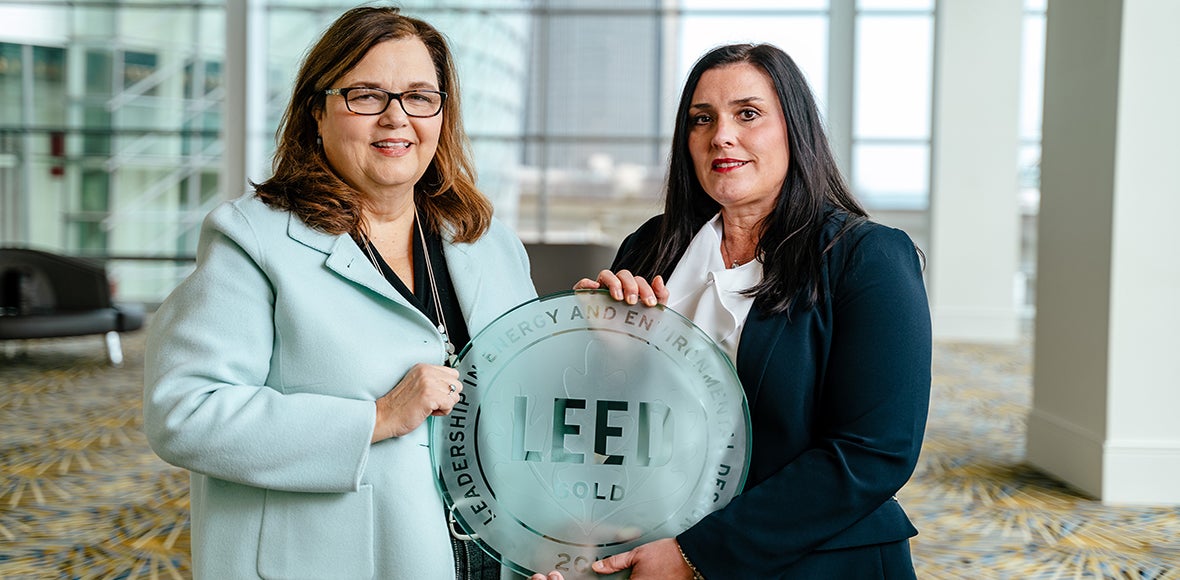
Huntington Place Green Committee Does It Again: LEED Gold Certification
After a rigorous application process, leadership at Huntington Place in Detroit is pleased to announce that the venue has again achieved LEED Gold status by recertifying under the LEED v4.1 O+M rating system, the most robust, flexible and transparent rating system to date. The convention center maintains its status as the largest LEED certified venue in Michigan.
LEED, or Leadership in Energy & Environmental Design, is a globally recognized symbol of excellence in green building. LEED certification ensures electricity cost savings, lower carbon emissions and healthier environments where people live, work, learn, play and worship. In the United States alone, buildings account for almost 40 percent of national CO2 emissions, but LEED-certified buildings have 34 percent lower CO2 emissions, consume 25 percent less energy and 11 percent less water, and have diverted more than 80 million tons of waste from landfills.
“To keep a high-performing green building, the Huntington Place team is dedicated to ongoing performance measurement and training,” said Becky Bixby, assistant general manager Huntington Place/ASM Global and LEED project manager. “We invest in educating employees, vendors, customers, partners and visitors on our efforts and the importance of sustainable practices.”
Huntington Place was recognized by LEED for several best practices resulting in the certification. The project scored very high in Human Experience which includes an Indoor Air Quality Evaluation – and demonstrates the building has excellent ventilation and air quality.

Curing the COVID-19 Pandemic while Huntington Place was closed for business, Gretchen Whitmer, Michigan’s Governor asked venue leadership to work with FEMA and become a field hospital and vaccine distribution center. The temporary site was designed to relieve the burden on local hospitals treating patients with COVID-19, equipped with patient oxygen supply and negative air pressure to accommodate healing.
Environmental air quality in the Atwater Garage was monitored in real-time for CO levels in the garage with 48 sensor readings that signal the engineering team to turn on the required sequence of 17 variable-speed exhaust fans. A twelve-foot by ten-foot video monitor with mapped locations of all CO sensors and exhaust fans is located in the engineering control room and watched by team members.
Both endeavors contributed to high scores for Huntington Place in the LEED Indoor Air Quality Evaluation and recertification as a LEED Gold building noting that the building was managed and controlled for minimum energy and water usage (or high energy/water performance) despite changes in occupancy, usage, or operations is really commendable.
The venue’s performance for water use was also highly rated. The building uses less water per square feet and per person than the local average through the use of very low flow plumbing fixtures and optimal cooling tower maintenance and operations.

Sustainability innovation is part of the venue’s Green mission, and new and innovative Green initiatives are continually implemented throughout the facility. Last month the Huntington Place Green Committee installed large recycling cages in the back of the house of exhibit halls to make it easier for labor building and deconstructing event spaces to recycle wood, glass, metal and other materials that can be collected and moved along material life cycles to stay out of the waste stream.
This month, Bixby officially became a LEED Green Associate, a professional credential highlighting her understanding of green building design, construction and operations attained after 16 hours of course work and exams. “I’m excited to be on this journey to help make Huntington Place a more sustainable venue for our customers and employees,” she said.
Huntington Place received the 2020 Leadership Award from the USGBC in recognition of leadership in driving the adoption of Leadership in Energy and Environmental Design (LEED) across business portfolios, higher education and green affordable housing, as well as helping to advance Environmental, Social and Governance (ESG) performance, resilience planning and innovative waste management solutions. Leadership Award recipients are a model for how LEED and other sustainability practices can be used to improve communities, support business, and contribute to a better future for all.
“Achieving LEED certification is more than just implementing sustainable practices. It represents a commitment to making the world a better place and influencing others to do better,” said Peter Templeton, president and CEO, USGBC. “Given the extraordinary importance of climate protection and the central role buildings play in that effort, Huntington Place is creating a path forward through their LEED certification.”
LEED is the most widely used green building rating system and a symbol of international excellence. Green buildings allow venues like Huntington Place to operate more sustainably and provide a healthier, more comfortable space for people to enjoy. More than 98,500 commercial and institutional projects are currently participating in LEED, comprising more than 21 billion square feet of construction space in all 50 states and more than 175 countries and territories. There are 213 LEED certified buildings in the Metro Detroit area.
“Huntington Place’s LEED certification demonstrates tremendous green building leadership,” said Templeton. “LEED was created to make the world a better place and revolutionize our buildings and communities by providing everyone with access to healthy, green and high performing buildings. Huntington Place is a prime example of how the innovative work of project teams can create local solutions that contribute to making a global difference.”
